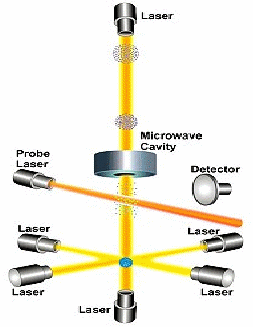Atomic clocks are based on a phenomena called atomic beam magnetic resonance. An atomic beam fired over a superconductor containing vortices will experience a time-dependent magnetic field.
Caesium atoms are placed in a copper tube that is surrounded by laser beams (four perpendicular and at right angles to each other and one above and one below).

When they are all turned on the cesium atoms gather at the very centre of the tube. Then all of the lasers except the one beneath the copper tube are turned off. The one beneath is turned off and on and the caesium atoms are moved up and down in a fountain-like action. To ensure precision, the clock is shielded from the Earth's magnetic field and the temperature is set to near absolute zero (-273 degrees Centigrade).
As the caesium atoms are thrown up by the laser beneath the tube, they go through a microwave-emitting cavity and then return via gravity through the same cavity. The microwaves are fired at a fluctuating rate around 9,192,631,770 Hertz - regulated by a vibrating crystal. The caesium atoms actually begin to glow or emit light. As the atoms change state, their change is measured. When the state changes are at their optimum, the number of Hertz (cycles per second) of the microwave is measured. This is used to adjust the crystal oscillator, which should now register true seconds.
